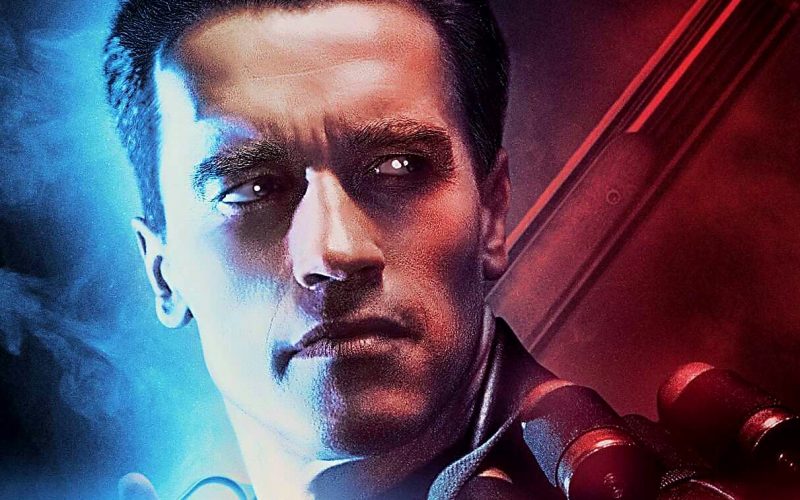Terminator 2: Judgment Day 3D.
Director James Cameron once declared himself “King of the World” and is now responsible for creating the films that occupy positions one and two on the list of highest grossing movies of all time (not adjusted for inflation). The most recent and most successful of those two films, Avatar, is now almost eight years old and is Cameron’s last theatrical feature save for his limited 2012 3D IMAX re-release of Titanic, his other film that sits at No.2 on the aforementioned list (at time of writing). The decision to remaster Titanic wasn’t just one that was made on a whim and as a quick cash-grab move. Cameron went to painstaking lengths to ensure that the 3D post conversion was done to his usual exacting standards to make the stereoscopic effect as convincing as possible going so far as to open up and reformat the frame from 2.35:1 to 1.78:1 to take advantage of the added depth granted by a taller image. The results were certainly impressive and an example of 3D post conversion done right.

Given that he’s still not delivered on his promised Avatar sequel(s), or anything else in the way of new theatrical releases for that matter, James Cameron has returned to the realms of post conversion 3D and has chosen arguably his most beloved film, Terminator 2: Judgment Day, to receive a 3D makeover. The 1991 sequel to his 1984 breakout film, The Terminator, T2 celebrates an anniversary of sorts this coming August 29th, the date of the film’s titular Judgment Day being that same date in 1997. So 20 years on from the fabled Judgment Day, Terminator 2 is back in cinemas. So, what’s been done and was it worth the effort? Well, aside from a post conversion into the 3D format, Cameron has painstakingly remastered the film, cleaning up the original image and giving it a fresh vibrancy that, coupled with the mostly subtle 3D conversion, works wonders to make the film look as strikingly immersive as possible.
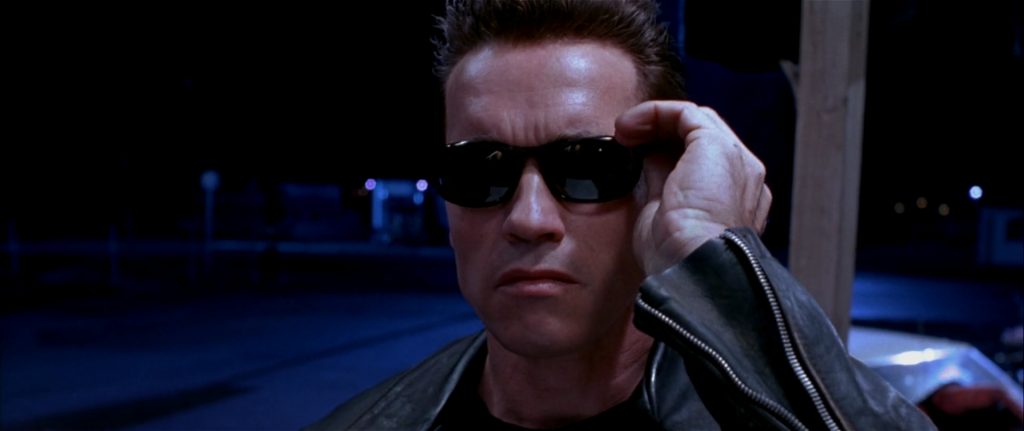
Given the level of CGI technology now at his disposal, technology he ushered in 26 years ago, Cameron has made only two minor alterations that I could see. The first is a small continuity correction of the windscreen of the tanker truck in the famous canal chase that miraculously replaces itself in the original after first falling out, that’s now been corrected. The second is overlaying Schwarzenegger’s likeness onto the face of the stunt double during the big motorcycle jump later on in the same scene. Both are acceptable changes and won’t detract in any way but serve to correct two very minor flaws in the original version.
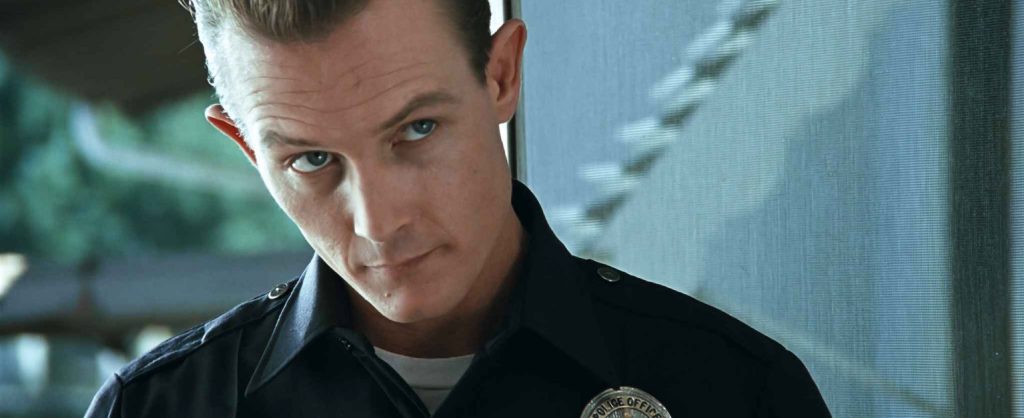 As he did with his Titanic 3D conversion, with T2:3D Cameron has opened up the frame vertically from the original theatrical aspect ratio of 2.35:1 to a slightly taller ratio. IMDB have this new aspect ratio listed as 1.85:1 but I believe it’s slightly wider than this, more like 2.00:1 or thereabouts. Whilst not sharing the often purposefully gimmicky look of some modern 3D films, T2 nevertheless has a new layer of subtle but often effective dimensionality that, coupled with the now pristine print, makes this a very worthwhile and satisfying theatrical exhibition of a film many are familiar with. Make no mistake, T2 has never looked better than it does here. As well as looking great, T2 in its new theatrical form sounds phenomenal. The score and dialogue are never anything other than perfectly clear with incredible bass and clarity across the channels.
As he did with his Titanic 3D conversion, with T2:3D Cameron has opened up the frame vertically from the original theatrical aspect ratio of 2.35:1 to a slightly taller ratio. IMDB have this new aspect ratio listed as 1.85:1 but I believe it’s slightly wider than this, more like 2.00:1 or thereabouts. Whilst not sharing the often purposefully gimmicky look of some modern 3D films, T2 nevertheless has a new layer of subtle but often effective dimensionality that, coupled with the now pristine print, makes this a very worthwhile and satisfying theatrical exhibition of a film many are familiar with. Make no mistake, T2 has never looked better than it does here. As well as looking great, T2 in its new theatrical form sounds phenomenal. The score and dialogue are never anything other than perfectly clear with incredible bass and clarity across the channels.
So what of the film itself?
It opens with a glimpse of the chaotic future war of what’s left of 2029 Los Angeles, we’d been here before in Cameron’s original 1984 film but just not on this scale. The opening to Cameron’s $100 million 1991 sequel aims to set the bar higher than we’d ever seen it set, grab our attention and not let go. It then moves into an opening credits sequence of a burning children’s playground, a haunting view of the coming nuclear war. This theme of the end of mankind permeates the film even more than in the original. We are, after all by this point, 3 years away from nuclear annihilation (the film is set in 1994, Judgment Day happens in 1997). It’s as Kyle Reese says to Sarah Connor in the first of two haunting nightmare sequences, in the extended version at least, “There’s not much time left in the world Sarah.” I say in the extended version, as that line, and Michael Biehn’s entire cameo are absent in this new theatrical presentation as Cameron has elected to present the original 137 minute theatrical cut as opposed to the 153 minute Special Edition that contains both of Sarah’s dream sequences as well as a raft of other worthy additional scenes. It’s the one gripe I have with this new version but I’m aware that there are many fans for whom the theatrical cut is the preferred version.
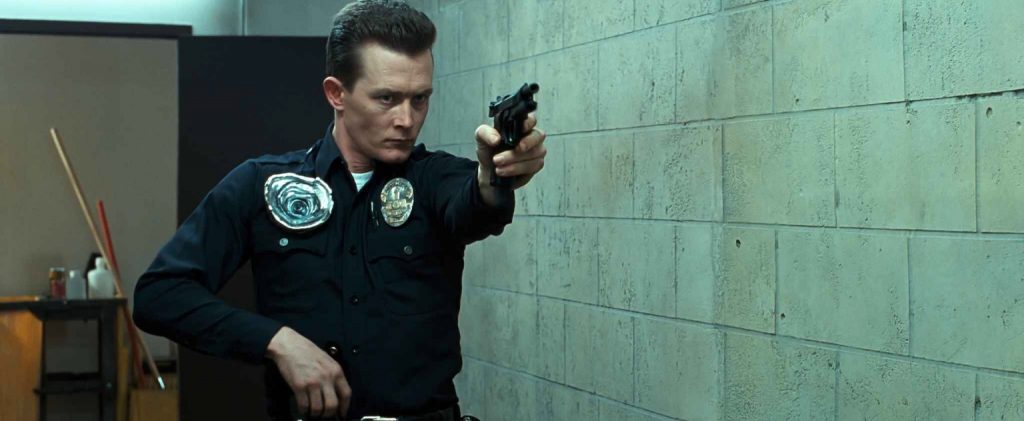 The beauty of Cameron’s film is not just in how it expands upon the scope of the original, but how the film itself changed the landscape of cinema much like Jaws did way back in the summer of 1975. This was a tent-pole summer blockbuster on a scale never before seen and, get this modern Hollywood, R rated! Yes, an R rated summer blockbuster! Let’s hope for a return to this sort of braver movie industry some day soon. If one is able to view T2 in isolation of its success and influence, it’s a superbly crafted slice of intelligent action sci-fi. Some have cited it as being somewhat bloated (in its extended form at least, personally I prefer the longer cut) and exuberant in comparison to the lean and gritty, low budget original, something I personally disagree with and anyway, is that really a bad thing and do the two films not perfectly complement one another?
The beauty of Cameron’s film is not just in how it expands upon the scope of the original, but how the film itself changed the landscape of cinema much like Jaws did way back in the summer of 1975. This was a tent-pole summer blockbuster on a scale never before seen and, get this modern Hollywood, R rated! Yes, an R rated summer blockbuster! Let’s hope for a return to this sort of braver movie industry some day soon. If one is able to view T2 in isolation of its success and influence, it’s a superbly crafted slice of intelligent action sci-fi. Some have cited it as being somewhat bloated (in its extended form at least, personally I prefer the longer cut) and exuberant in comparison to the lean and gritty, low budget original, something I personally disagree with and anyway, is that really a bad thing and do the two films not perfectly complement one another?
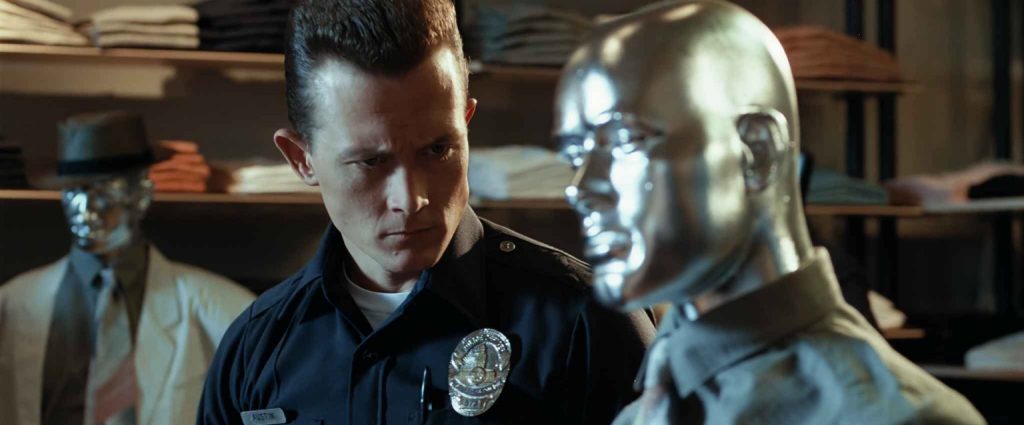
After his incredibly fraught shoot on 1989’s The Abyss, (he didn’t actually finish that film to his satisfaction until The Abyss: Special Edition in 1993) Cameron made sure that another ambitious project such as T2 would not suffer such troubles. He assembled the very finest crew (sound effects, editing and cinematography especially) and the quality of their work is all up there on screen. It’s easily one of the most consistently beautifully shot films of the genre, unless of course you really don’t like steely blue hues.

The pioneering special effects, in particular the then cutting edge CGI by Industrial Light & Magic (ILM), still holds up better than the work of many modern day effects houses. Take for example the shot where the T-1000 reforms yet again after being frozen and shattered. As his liquid metal form rises from the floor of the steel mill, the camera pans around him perfectly capturing the fiery reflections of its surroundings. It was a flawless shot in 1991 and remains so today and is one of many similarly jaw dropping shots peppered throughout the film. The sheer inventiveness of the various ways in which the T-1000’s morphing abilities are put to use are incredible to behold and to think that this was all stuff that had never even been attempted before but which still looks incredibly convincing 26 years on is testament to the incredible work of ILM and the numerous other effects houses that worked on the film. That image of the partially formed, chrome coloured T-1000 coolly waking out of a flaming truck wreck left jaws on floors in ’91 and the subsequent imagery of the aforementioned acts of morphing were like nothing audiences had ever seen before. Has there been a more innocuous looking yet totally unstoppable movie villain before or since? Unlike the subsequent slew of films that either overused or poorly implemented computer effects, in T2 they serve the plot first and foremost.
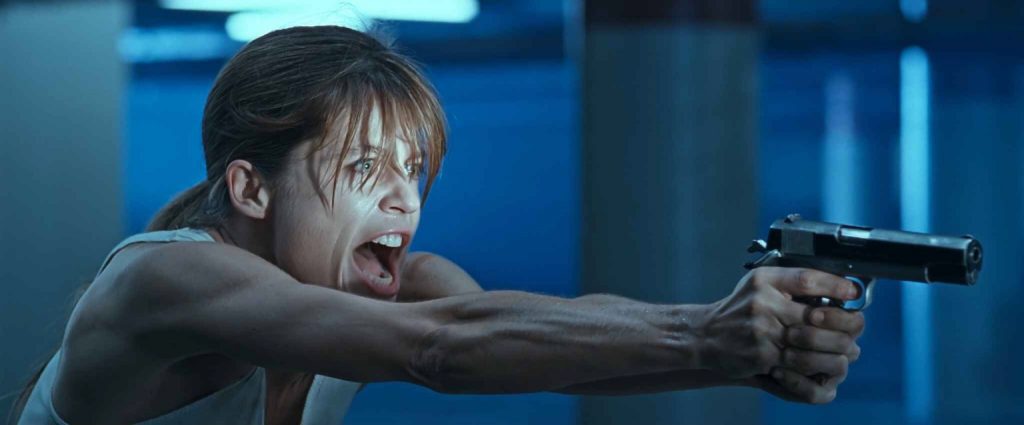
As well as the sublime visuals, made all the more sumptuous by the incredible remastering process the film has undergone, special mention must be made of Brad Fiedel’s stunning score. Like the very best film scores, Fiedel’s music in T2 works to both enhance the tension and tempo of the many frenetic action scenes but is also equal parts somber and hauntingly contemplative in the scenes where the impending apocalypse is being either imagined, dreamt or debated over by its characters. It truly is one of the very best film scores I’ve ever heard and quite how Fiedel never went on to be recognised as one of the all-time great film composers is beyond me. He just never seemed to do anything of note after T2 and Cameron’s later film True Lies which is such a shame as his talent for creating effective film scores is unquestionable.
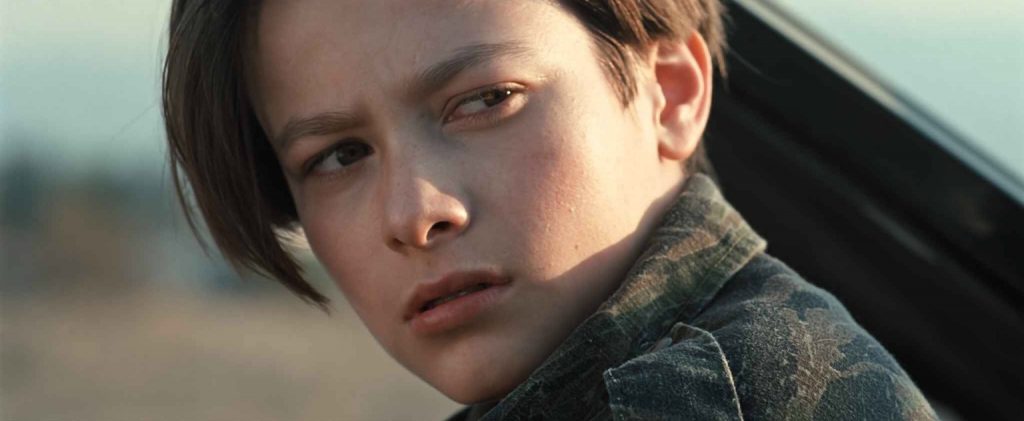
I’ll address one popular criticism of T2 over its predecessor, namely Arnie being the good guy. The original idea for the first film was that the Terminator’s appearance would be that of a regular Joe who would just blend into a crowd, as opposed to the imposing frame of the Austrian Oak (hardly a subtle infiltration unit). Robert Patrick’s police officer garbed T-1000 was just that, a chameleon, a shape shifter, he could be anyone. Therein lay the threat. Returning cast members were on board and at the top of their game. A ripped, lean Linda Hamilton famously getting into superhuman shape to play a much harder, weathered Sarah Connor is better than she’s ever been. Michael Biehn (a well implemented cameo in the extended version that is sadly absent in this 3D version) and Earl Boen reprise their respective roles from the original. Some deride Edward Furlong’s John Connor, but in comparison to some other first time child actors I can think of (poor Jake Lloyd for example) his performance is more than acceptable.
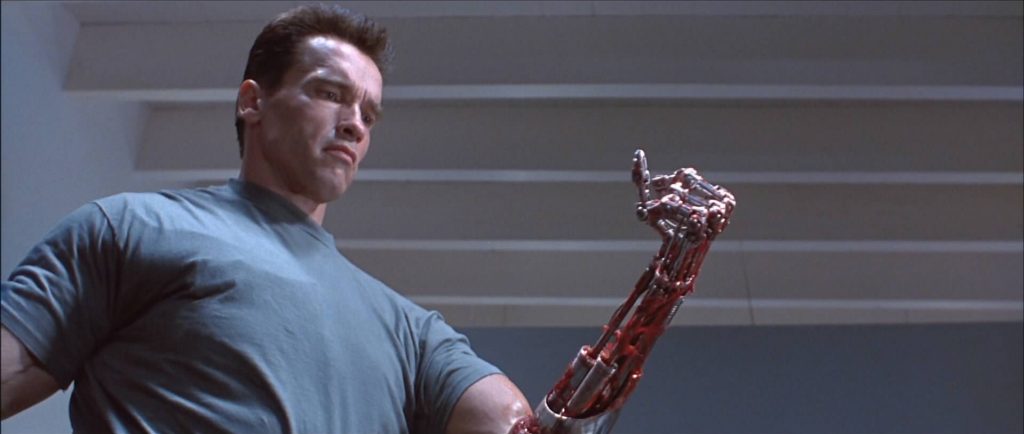
Writer, William Wisher (he cameos as ‘guy with camera in mall’ fact fans) ran with an idea deleted from the original, namely Sarah’s idea to go after and stop Cyberdyne Systems. Instead of portraying the man who develops Skynet as a typically clichéd driven, power-mad scientist, here Joe Morton gives us a decent family man faced with the sickening realisation that his well intentioned day job will cause mankind’s extinction. I’d just call in sick. The film moves from one superbly choreographed, action set-piece to the next. Its lengthy runtime suitably balanced by several quieter reflective character moments. Brad Fiedel’s aforementioned score complements these scenes perfectly, lending the story an even greater sense of the impending apocalypse that Sarah knows is coming. The pace of the film, while maybe not as continually break-neck as the first, still keeps you on edge throughout and there’s a sense of purposeful editorial precision that is plainly evident throughout the entire film. The film’s more contemplative moments, where humanity’s self destructive fate is conveyed, are amongst T2‘s best scenes and act as a sufficient buffer to allow breathing space between the action scenes but ultimately form the beating heart of the film that marks it head and shoulders above its contemporaries.
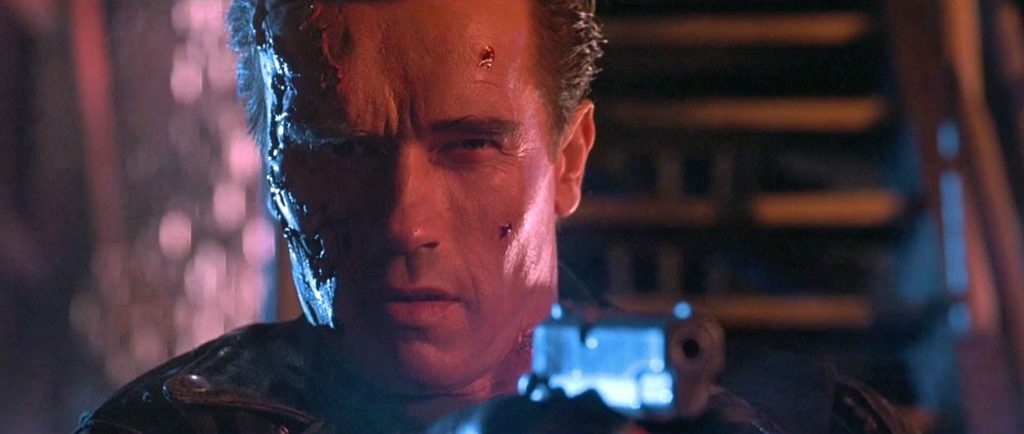 I’m occasionally torn as to whether T2 is a better film than the first. Then I think back to how the film made such an impact upon both myself and the world of film in that now distant summer of 1991. Never had such a well crafted, roller coaster ride of a film been seen. Yes, I do question the need for some of the film’s lighter, more humorous moments, but I am willing to forgive them in light of the exceptional overall quality of the movie, a film that hasn’t noticeably aged at all in 26 years. T2 was the ultimate game changer of the early to mid 90’s. It gave us things we hadn’t seen before, revolutionised the field of special effects and was a sequel easily as good as, if not better than the original. T2 remains my most cherished cinema-going experience and to see it once more, looking better than it ever has in a respectfully handled 3D conversion was an incredible experience, one that felt both fresh and yet played upon my deep nostalgia for the film. For those too young to have seen it back in 1991, this limited re-release of T2 presents a rare opportunity that I urge you not to pass up. Films don’t get much better than this and opportunities to relive a cherished experience from over a quarter of a century ago are a rarity. Thank you very much Mr Cameron.
I’m occasionally torn as to whether T2 is a better film than the first. Then I think back to how the film made such an impact upon both myself and the world of film in that now distant summer of 1991. Never had such a well crafted, roller coaster ride of a film been seen. Yes, I do question the need for some of the film’s lighter, more humorous moments, but I am willing to forgive them in light of the exceptional overall quality of the movie, a film that hasn’t noticeably aged at all in 26 years. T2 was the ultimate game changer of the early to mid 90’s. It gave us things we hadn’t seen before, revolutionised the field of special effects and was a sequel easily as good as, if not better than the original. T2 remains my most cherished cinema-going experience and to see it once more, looking better than it ever has in a respectfully handled 3D conversion was an incredible experience, one that felt both fresh and yet played upon my deep nostalgia for the film. For those too young to have seen it back in 1991, this limited re-release of T2 presents a rare opportunity that I urge you not to pass up. Films don’t get much better than this and opportunities to relive a cherished experience from over a quarter of a century ago are a rarity. Thank you very much Mr Cameron.
Film ’89 Verdict – 10/10

